National Depression Glass Association
Preserving America's Glass Manufacturing Heritage
What is Depression Glass ?
by David Adams
For those of you visiting the NDGA web site for the first time, you may be wondering about the term "Depression Glass". Just what is this all about, anyway? Why would someone have a web page, let alone a National Organization, having to do with something called "Depression Glass" ?
Or you may think "I know what 'Depression Glass' is -- it's that pink and green and yellow glassware that Grandma used to have". And "didn't we throw that stuff away years ago?".
"Isn't that stuff just junk?". Or even "that stuff -- they gave that away in Quaker Oats boxes.".
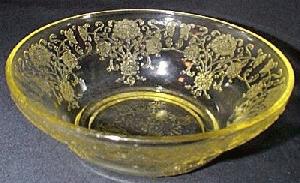 We're
going to tell you all about "Depression Glass", maybe more than you
really wanted to know about it, but that's what this web site is
all about. One of the goals of our Organization is to educate
people regarding the glassware that we collect and preserve.
We're
going to tell you all about "Depression Glass", maybe more than you
really wanted to know about it, but that's what this web site is
all about. One of the goals of our Organization is to educate
people regarding the glassware that we collect and preserve.
Definitions
Although the "Depression" years extended from late 1929 up to the start of World War II, the term "Depression Glass" refers to American-manufactured transparent glassware that was manufactured from the early to mid-1920's, through around the end of World War II. Much of that time was considered the "Great Depression", but the glassmaking period extended out on both sides of the "Great Depression".
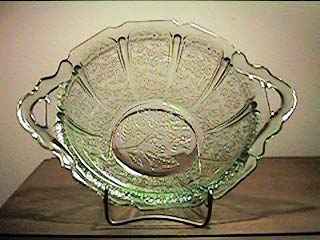 We generally use the term "Depression
Glass" to describe colored, transparent glassware made at that
time. Of course, the companies also manufactured a good deal of
clear crystal glassware during the same period. This is also
considered "Depression Glass". Some patterns continued to be
produced into the 1950's and even later. And some glass made during
the period was opaque, and some glass was decorated with gold,
platinum or even colored enamel. The most distinguishing thing
about "Depression Glass" is really the time of manufacture.
We generally use the term "Depression
Glass" to describe colored, transparent glassware made at that
time. Of course, the companies also manufactured a good deal of
clear crystal glassware during the same period. This is also
considered "Depression Glass". Some patterns continued to be
produced into the 1950's and even later. And some glass made during
the period was opaque, and some glass was decorated with gold,
platinum or even colored enamel. The most distinguishing thing
about "Depression Glass" is really the time of manufacture.
Depression and "Elegant" glass
One of the best known authors of books on this type of glassware, at least in today's market, is Mr. Gene Florence. And we credit him with developing the terminology which divides "Depression Glass" into two distinct classes: "Elegant Glass" and "Depression Glass". The "Elegant" glass was manufactured by a relatively small number of companies, known as "Hand" houses, because a great deal of hand finishing was done to the glass after it was removed from the mold. The companies which manufactured what we term "Depression" glass (or abbreviated hereafter as "DG") would add little to no hand finishing or treatments to the glass once it was came out of the mold. Some of the treatments which were done by the "Hand" houses included: fire polishing the piece to remove "mold marks", grinding the bottoms of some pieces so that they would sit perfectly flat, acid-etching a pattern into the glass (after it had cooled), or cutting a pattern into the glass using a copper cutting wheel. The "Elegant" companies added touches like this, while the "DG" companies rarely did so.
Many of the patterns of what we call "Depression Glass" were
distributed as promotional items during the lean years. "DG" 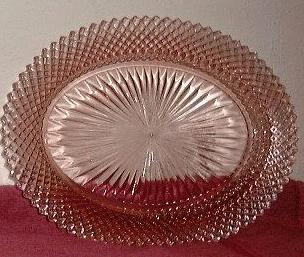 items
would appear in soap or cereal boxes, or might be given away at a
local movie theater or gas station to encourage patrons. In fact,
one Glass manufacturer was saved from bankruptcy during the
Depression when it received an order from Quaker Oats for
five Railroad Cars of glass !
items
would appear in soap or cereal boxes, or might be given away at a
local movie theater or gas station to encourage patrons. In fact,
one Glass manufacturer was saved from bankruptcy during the
Depression when it received an order from Quaker Oats for
five Railroad Cars of glass !
Immediately preceding the years of the Great Depression, there were well over 100 companies manufacturing glass in the United States. By the time the Depression ended, there remained less than half that number. In addition to bankruptcy and mergers, fire was one of the major reasons that companies ceased operations. Factories that burned down during the Depression years were rarely rebuilt -- instead, the company would simply cease operations.
Colors, colors, colors ...
The question often comes up: "What were the colors of Depression
Glass ?". That's really a tough one to answer. The predominant
colors of the era were: Amber ... Yellow ... Pink ... Green ...
Blue ... and, of course, Crystal. But nearly any other color you
can think of was also made during this time period. The demand for
"carnival" glass had disappeared, although some 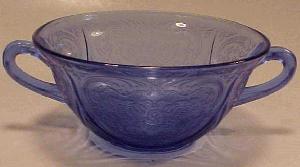 companies still produced a small amount of that type of treatment.
There was a short time when several of the companies competed with
an "alexandrite" type of color (lavender, changes color in
different light), but the color did not prove popular in those
times, and it usually was of short-duration production. One company
produced a bright orange color (Heisey, Tangerine), which was
definitely a slow seller and which was discontinued after a short
run. These short-run colors now command hefty prices in the
collector market, primarily due to the limited production runs.
companies still produced a small amount of that type of treatment.
There was a short time when several of the companies competed with
an "alexandrite" type of color (lavender, changes color in
different light), but the color did not prove popular in those
times, and it usually was of short-duration production. One company
produced a bright orange color (Heisey, Tangerine), which was
definitely a slow seller and which was discontinued after a short
run. These short-run colors now command hefty prices in the
collector market, primarily due to the limited production runs.
The dominant home decorator colors of the time period were yellow and amber. This probably at least partially explains the abundance of patterns and pieces in these colors today. Larger quantities of these colors were originally produced, and the demand in today's market seems to be centered on the pink, green and blue colors, more than on yellow and amber. So it should really be of no surprise that the former colors command a higher price than the latter ones.
Speaking of pricing ...
When one reads some of the original advertisements of the time,
or even better, the price lists from the manufacturer, eyes open
wide at the prices. Quite often, pieces were priced by the dozen or
even by the barrel (containing perhaps five or six dozen). Prices
of 14 cents each, or $1.72 per dozen were rather common. Vases sold
in groups of six, intended to retail at 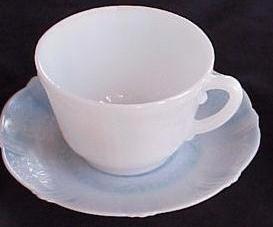 "less than a dollar apiece". Today, these same pieces may command
hundreds of dollars each !
"less than a dollar apiece". Today, these same pieces may command
hundreds of dollars each !
This writer owns a pair of candlesticks which retail in today's market at about $1500 for the pair. They still have the original sticker from the Department store in Denver, CO, where they were purchased for $3.60 for the PAIR! How would you like to have ordered a barrel of those beauties?
The "price guides" that you see available in bookstores and on the web need a bit of explaining, and this is probably the best time and forum to do so. Selling prices for items that were made over 70 years ago largely depend upon demand by collectors, and supply, meaning availability in this case, since we can't order any more from the factories, most of which are long out of business. Hmmmm, "supply and demand". Sounds like commerce, doesn't it? And that's exactly what it is.
Location, location, location
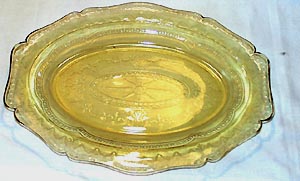 But there's a bit more to it than that.
The area of the country in which you are located plays a tremendous
part in pricing of DG and Elegant glass. Parts of the midwest are
"hot" spots for DG, but not as much for Elegant. Some areas (like
L.A.) are "hot" areas for Elegant and so on. So the "price" of an
item often depends on where it is being sold. To publish a
"price guide" that realistically "guides" you to a rock-solid
retail price for an item, Nationwide, is an impossible feat. It
cannot be done. The "book" prices for this glassware reflect
only the Author's best attempt, and do NOT constitute hard and fast
prices that you can expect in all areas of the country. The
sooner we all agree on that statement, the better off we all will
be. Pricing depends primarily on "supply and demand", and as with
any Antique item, "the time to buy an Antique is when you see
it."
But there's a bit more to it than that.
The area of the country in which you are located plays a tremendous
part in pricing of DG and Elegant glass. Parts of the midwest are
"hot" spots for DG, but not as much for Elegant. Some areas (like
L.A.) are "hot" areas for Elegant and so on. So the "price" of an
item often depends on where it is being sold. To publish a
"price guide" that realistically "guides" you to a rock-solid
retail price for an item, Nationwide, is an impossible feat. It
cannot be done. The "book" prices for this glassware reflect
only the Author's best attempt, and do NOT constitute hard and fast
prices that you can expect in all areas of the country. The
sooner we all agree on that statement, the better off we all will
be. Pricing depends primarily on "supply and demand", and as with
any Antique item, "the time to buy an Antique is when you see
it."
"Adam to Windsor" and more ...
On another section of this web site, you'll see a reference to
"Adam to Windsor", and may wonder about the terminology. Both 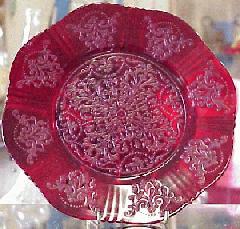 "Adam" and "Windsor" are patterns of Depression Glass. And there
are a whole bunch of other patterns which range, alphabetically, in
between these two. When a Depression Glass enthusiast refers to the
whole field of DG patterns, they often say "Adam to Windsor". This
term refers to the machine-made DG patterns, as opposed to the
"Elegant" patterns produced by the "hand-made" glassware companies.
It is our intention to some day display photographs of at least one
piece in each of the "Adam to Windsor" patterns on a series of
educational web pages at this site. That is a project which is just
beginning to take shape. We also intend to provide photographs of
pieces in many of the more commonly collected "Elegant"
patterns.
"Adam" and "Windsor" are patterns of Depression Glass. And there
are a whole bunch of other patterns which range, alphabetically, in
between these two. When a Depression Glass enthusiast refers to the
whole field of DG patterns, they often say "Adam to Windsor". This
term refers to the machine-made DG patterns, as opposed to the
"Elegant" patterns produced by the "hand-made" glassware companies.
It is our intention to some day display photographs of at least one
piece in each of the "Adam to Windsor" patterns on a series of
educational web pages at this site. That is a project which is just
beginning to take shape. We also intend to provide photographs of
pieces in many of the more commonly collected "Elegant"
patterns.
Well, that about covers the topic we started with. You now know what Depression Glass is, and have seen a few examples interspersed with a whole lot of words. The remaining pages on our web site are intended to let you learn more about the companies and the glass itself. We hope to encourage you to begin collecting or to expand a collection that was handed down to you from someone in your family. We believe that this glass represents an art form that has slowly disappeared from the American scene. We join together to preserve both the history and the art form and to educate others along the way. Please join us. And thanks for your visit.